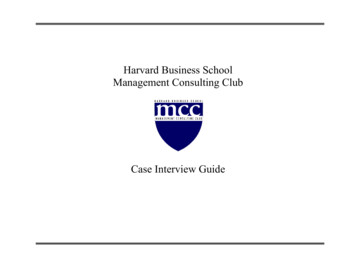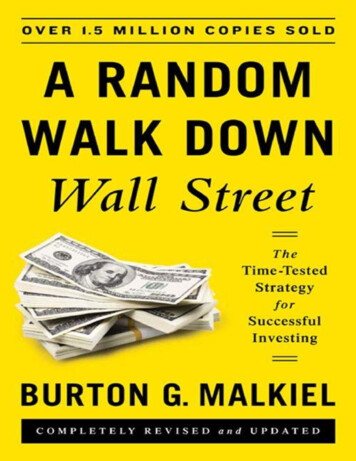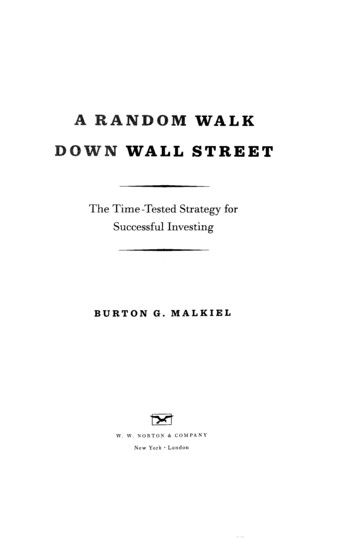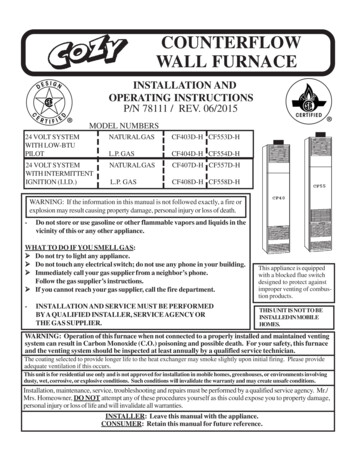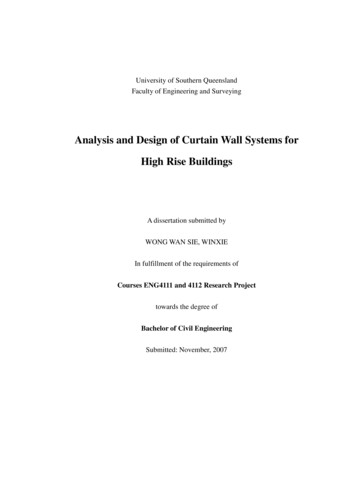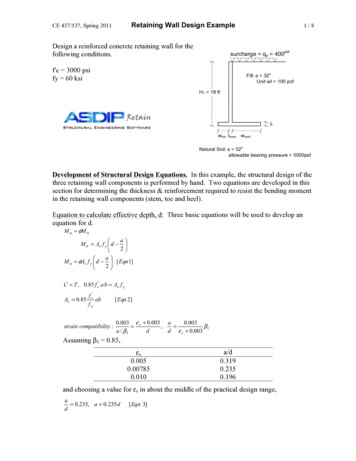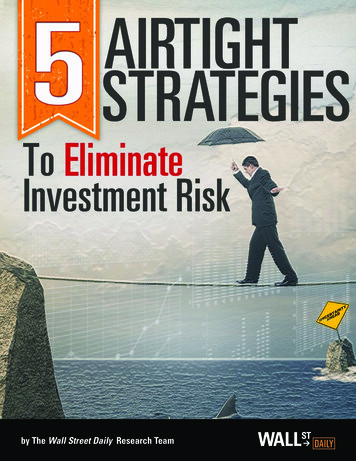
Transcription
by The Wall Street Daily Research Team
5 AIRTIGHT STRATEGIESTo Eliminate Investment RiskThere might be no guarantees in the stock market, but thatdoesn’t mean you can’t minimize – or even eliminate – risk.In fact, there are five simple things you can do to nab riskfree returns.You can: Buy and sell options as insurance. Execute a “pairs trade.” Take advantage of merger arbitrage. Invest in a special “MarketSafe” CD Use political intelligence.Just applying these techniques will lower your risksubstantially and put you on the path to superior returns.Here’s a quick breakdown of how each strategy works 2
HOW TO USE OPTIONSAS INSURANCEOne way to eliminate risk is to hedge - or use options as insurance.For example, say you purchase 1,000 shares of Company ABC at 30. The totalpotential loss for this trade (if the stock went to 0) would be 30,000.Using options as insurance allows you to slash that risk considerably.Here’s how that would work After you purchase the shares, simply buy put-option contracts on ABC witha strike price of 30. Since one option contract equals 100 shares, buying 10contracts would cover your entire 1,000-share position.If the puts were trading for 1 each, 10 contracts would cost you 1,000.How does paying another 1,000 help you?Well, should the price of ABC’s shares fall, the value of your puts will increase.And this provides a nice element of safety.Let’s look at some example payoffs:The stock went up to 40:Now your 30,000 investment is worth 40,000. However, you did lose 1,000from buying the put option (bringing your total to 39,000). So buying thehedge reduces your returns in this case.The stock dropped to 20:3
ABC’s shares are worth 20,000. But since your puts allow youto collect 30 for the shares, you actually end up with 29,000( 30,000 - 1,000 from buying the put options). That’s a loss. Butit’s a lot easier to take than the 10,000 you would have lost onthe position without a hedge.Another way you could do it is sell the shares for 20,000 andthen just sell your puts. Again, while a stock falls, the value ofputs increase. With this option, your total would end up beingabout the same.The stock stays the same:“Pairs trading”gives investors thechance to profitfrom virtually anymarket movement– whether stocksgo up, down, orsideways. And it’sa relatively simpleconcept to master.In this case, you lose the 1,000 you spent on the option. Soinstituting a hedge does lower your returns. But more important, itsaves you from even bigger losses if your investments go wrong.Of course, you can always alter the strike prices or expirationdates to get more or less protection. This would also change thecost of the puts.BREAKING DOWN THEPAIRS TRADING STRATEGY“Pairs trading” gives investors the chance to profit from virtuallyany market movement – whether stocks go up, down, orsideways. And it’s a relatively simple concept to master.All you have to do is find two stocks that are similar to oneanother – companies in the same industry and are about the4
same size. And their share prices should show a strong correlation.A good example would be The Coca-Cola Co. (NYSE: KO) andPepsiCo (NYSE: PEP), which have virtually identical five- and10-year charts.Then you watch the two stocks until the correlation temporarilyweakens. That is, one moves up while the other declines or staysflat.This strategycomes with verylittle risk, sinceboth your longand short bets areconcentrated on asingle sector.Once that happens, you “short” the outperforming stock and “golong” on the one that’s underperforming. With this tactic, you’reessentially betting that the spread between the two stocks willreconverge.This strategy comes with very little risk, since both your long andshort bets are concentrated on a single sector. So the gain on thelong stock is offset by a loss on the short.Of course, the hardest part here is simply identifying two stocksthat have this high correlation to one another. But again, it startswith finding two competitors that are roughly the same size anddo basically the same thing. This website can help you get started.MERGER ARBITRAGE:THE SAFEST WAY TOCASH IN ON ACQUISITIONMergers and acquisitions (M&A) are some of the most dynamicprofit opportunities the market has to offer. They’re also some ofthe most consistent.5
And that means there’s a limited amount of risk.You see, when Company A acquires Company B, it proposes to buyCompany B’s shares for more than their market price. Once thathappens, shares of Company B shoot up toward the offer price.However, they tend to stop about 3% to 5% shy.The reason this “spread” exists is straightforward: It’s the market’s way of pricing the time it will take to It also serves as a risk premium to compensate for the complete the deal.This is called“mergerarbitrage,”and it’s a battletested strategy.In fact, it’s beena mainstay ofinstitutional andhigh-net-worthportfolios fordecades.”possibility of the deal falling through.Based on a recent study in the Financial Analysts Journal, though,only 8% of announced takeover deals have failed to close since 1990.Put another way, for 92 out of 100 takeovers, the spread is essentiallyrisk-free money waiting to be claimed.All you have to do is buy shares of the target company after a deal isannounced.Once the deal closes, the cash equivalent to the full offer price willappear in your account. And you’ll have earned the spread in theprocess. Since the typical merger closes within four months, youcan invest in several deals over the course of the year and earn arespectable double-digit return.This is called “merger arbitrage,” and it’s a battle-tested strategy.In fact, it’s been a mainstay of institutional and high-net-worthportfolios for decades.And the best part is, you don’t even have to scan the daily headlinesfor takeover announcements to identify the best merger arbitrageopportunities.6
You can simply invest in one of two merger arbitrage funds: The Merger Fund (MERFX) The Arbitrage Fund (ARBFX)Both are no-load funds with reasonable expenses, run by managersthat have invested in merger arbitrage opportunities for over adecade.ELIMINATE 100%OF YOUR RISK WITHEVERBANK’S MARKETSAFE CDEverBank has developed an investment product that’s the perfectfit for any zero-risk portfolio: the MarketSafe CD.When available, these CDs give you the chance to participatein several markets while raking in solid returns at maturity.EverBank’s Emerging Markets CD, for instance, gave investorsexposure to four currencies: the Columbian peso, the SouthKorean won, the Israeli shekel and the Turkish lira.If the market that particular product focuses on goes up, you get tocash in on the uptick.Even if the market plummets, however, you walk away with 100%of your principal deposit at maturity. No questions asked.The ability to gain exposure to several markets at once, alongwith the peace of mind in knowing that your initial investment isprotected? Now we’re talking!7
GAIN AN EDGEOVER THE INVESTING HERDWITH POLITICAL INTELLIGENCEThe fifth way to eliminate investment risk is usually out of reach for most investors.It involves gaining access to the same information politicians are privy to on CapitolHill.We’re talking about political intelligence. And having enough of it can eliminate allof the risk inherent to investing.Here’s an example of how Back on March 18, 2008, when she was still Speaker of the House, Nancy Pelosimade an enormous bet on Visa (NYSE: V) – now regarded as one of the mostlucrative initial public offerings in American history.Of course, no one knew at the time that Visa was certain to perform so well. That is,unless you had advanced political intelligence.You see, just 12 days prior to Visa’s IPO, an ominous piece of legislation was makingits way through Congress.It was called the Credit Card Fair Fee Act. This bill addressed something called an“interchange fee,” which retailers must pay to Visa every time someone swipes acard in their store. As such, it had the power to kill Visa’s IPO.The bill had 45 congressional sponsors, it passed the Judiciary Committee by a 1916 vote, and even public surveys showed that 77% of Americans supported the bill.But what most people didn’t know is that Visa made up as much as half of SpeakerPelosi’s portfolio Half!8
Knowing that now, you can probably guess how this played out: Pelosi made surethat the bill never made it to the House floor for a hearing. And ultimately, it diedwithout a whimper.How’d Pelosi fare on her bet? Well, Visa shares opened at 45 and two days laterthey surged to 65. Shortly after that, they hit 85. And the stock jumped up to over 260 before a 4:1 split in March 2015. Imagine if you’d known what Nancy Pelosidid Well We did!Wall Street Daily began coverage on Visa’s IPO all the way back in February of 2007.Meanwhile, our field analysts collected political intelligence on the Credit Card FairFee Act – the biggest obstacle standing in the way of a price explosion.And as long as the House of Representatives didn’t schedule a hearing on the bill, wewere prepared to issue a “Buy” on the stock. And that’s exactly what we did.Indeed, we have the same political connections members of Congress used to buildtheir fortunes. So you’ll have the ability to mimic their success - dollar-for dollar.In fact, you can start your own investigation by going to this site. If you identify atrend that you believe holds investment merit, feel free to send it our way for furtheranalysis: customerservice@wallstreetdailyinfo.com.BOTTOM LINE:As long as you’re part of the Wall Street Daily Nation, you’ll learn firsthand how toput these risk-eliminating strategies to good use. Keep a close eye on your email forthe next alert to see for yourself.Good investing,The Wall Street Daily Research Team9
In a world of liars, theTRUTHstarts here.Nothing published by Wall Street Daily should be considered personalized investment advice. Although our employees may answer your generalcustomer service questions, they are not licensed under securities laws to address your particular investment situation. No communication byour employees to you should be deemed as personalized investment advice. We expressly forbid our writers from having a financial interest inany security recommended to our readers. All of our employees and agents must wait 24 hours after on-line publication, or 72 hours after themailing of printed-only publication prior to following an initial recommendation. Any investments recommended by Wall Street Daily shouldbe made only after consulting with your investment advisor and only after reviewing the prospectus or financial statements of the company.105 West Monument Street, Baltimore, MD 21201 3.353.4052F. 410.223.265006262015 20152014 Wall Street Daily, LLC. All rights reserved.
Invest in a special “MarketSafe” CD Use political intelligence. Just applying these techniques will lower your risk substantially and put you on the path to superior returns. Here’s a quick breakdown of how each strategy works T
